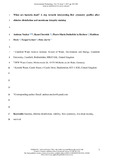JavaScript is disabled for your browser. Some features of this site may not work without it.
| dc.contributor.author | Nocker, A. | |
| dc.contributor.author | Cheswick, R. | |
| dc.contributor.author | Dutheil de la Rochere, P. M. | |
| dc.contributor.author | Denis, M. | |
| dc.contributor.author | Léziart, T. | |
| dc.contributor.author | Jarvis, Peter | |
| dc.date.accessioned | 2017-02-06T14:40:01Z | |
| dc.date.available | 2017-02-06T14:40:01Z | |
| dc.date.issued | 2016-12-05 | |
| dc.identifier.citation | Nocker A, Cheswick R. et al., When are bacteria dead? A step towards interpreting flow cytometry profiles after chlorine disinfection and membrane integrity staining, Environmental Technology, Volume 38, Issue 7, 2017, pp. 891-900 | en_UK |
| dc.identifier.issn | 0959-3330 | |
| dc.identifier.uri | http://dx.doi.org/10.1080/09593330.2016.1262463 | |
| dc.identifier.uri | http://dspace.lib.cranfield.ac.uk/handle/1826/11386 | |
| dc.description.abstract | Flow cytometry is increasingly employed by drinking water providers. Its use with appropriate fluorescent stains allows the distinction between intact and membrane-damaged bacteria, which makes it ideally suited for assessment of disinfection efficiency. In contrast to plate counting, the technology allows the visualization of the gradual loss of membrane integrity. Although this sensitivity per se is very positive, it creates the problem of how this detailed viability information compares with binary plate counts where a colony is either formed or not. Guidelines are therefore needed to facilitate interpretation of flow cytometry results and to determine a degree of membrane damage where bacteria can be considered ‘dead’. In this study we subjected Escherichia coli and environmental microorganisms in real water to increasing chlorine concentrations. Resulting flow cytometric patterns after membrane integrity staining were compared with culturability and in part with redox activity. For laboratory-grown bacteria, culturability was lost at lower disinfectant concentrations than membrane integrity making the latter a conservative viability parameter. No recovery from chlorine was observed for four days. For real water, loss of membrane integrity had to be much more substantial to completely suppress colony formation, probably due to the heterogenic composition of the natural microbial community with different members having different susceptibilities to the disinfectant. | en_UK |
| dc.language.iso | en | en_UK |
| dc.publisher | Taylor & Francis: STM, Behavioural Science and Public Health Titles | en_UK |
| dc.rights | Attribution-NonCommercial 4.0 International | |
| dc.rights.uri | http://creativecommons.org/licenses/by-nc/4.0/ | |
| dc.subject | Bacteria | en_UK |
| dc.subject | chlorine disinfection | en_UK |
| dc.subject | viability | en_UK |
| dc.subject | flow cytometry | en_UK |
| dc.subject | live-dead staining | en_UK |
| dc.subject | survival | en_UK |
| dc.title | When are bacteria dead? A step towards interpreting flow cytometry profiles after chlorine disinfection and membrane integrity staining | en_UK |
| dc.type | Article | en_UK |
Files in this item
This item appears in the following Collection(s)
-
Staff publications (SWEE) [2825]

